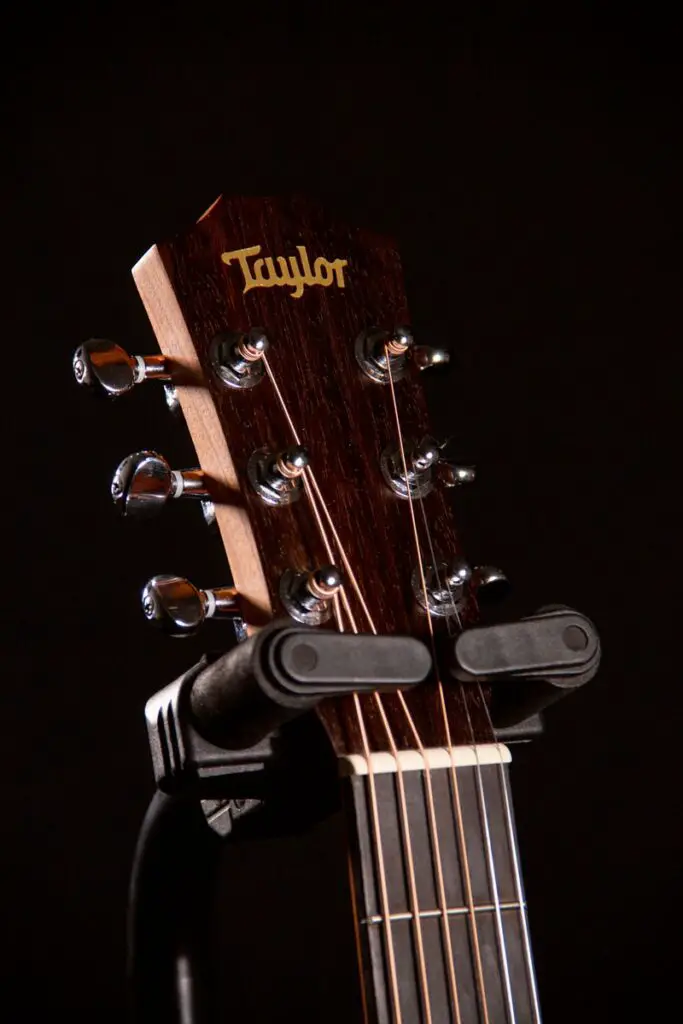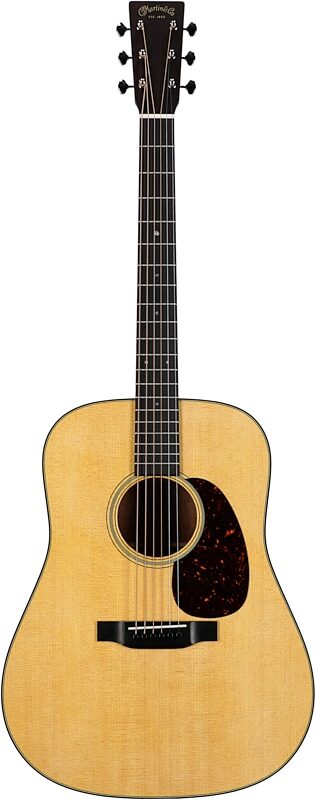
The acoustic guitar industry is dominated by several big brands so it’s normal to get confused between choosing between top acoustic names like Martin, Taylor, Yamaha, and more. It’s always a good idea to compare brands before concluding which one to choose.
That’s why I wanted to put together this guide where we compare Taylor vs Martin guitars. Both brands produce different ranges of acoustic guitar models.
That said, to help give us some focus, this guide will specifically compare the Taylor 110e to the Martin D-18 produced by these brands. Rather than trying to just compare the brands in general I chose one of the most popular acoustic guitars from each company.
Taylor and Martin both have a reputation of producing high-quality guitars that have been used by popular professional guitar players.
My Martin vs Taylor guitar comparison will walk you through the key features of both guitar brands and help you make an informed decision based on your proposed requirements. Here we go:
Key Differences Between Martin vs Taylor Guitars
While both Martin and Taylor make high quality acoustic instruments, there are a few main differences to be aware of between these two brands of guitars:
- Taylor guitars are modern and classic, while Martin guitars focus more on traditional/classic sounds.
- Taylor guitars has their average standard fretboard radius at 15-inches while the Martin Guitars has 16-inches fretboard radius
- Taylor guitars are designed in a way that their necks are adjustable (depending on the changes that happen over time), while Martin guitars do not come with adjustable necks
- Taylor guitars feature V-bracing while Martin guitars use the traditional X-bracing
- Taylor started operation in 1974 while Martin has been around for as far back as 1833, making them a much older brand.
Taylor Guitars – An Overview
Let’s evaluate some of the distinctive Taylor and Martin guitar features, starting with Taylor.
A professional approach to creating acoustic guitars has earned Taylor a quality reputation through the years. Although they’re relatively young when compared to the legacy guitar brands like the Martins and Gibsons of the world, a lot of guitarists have accepted Taylors as one of the best acoustic guitars on the marketplace.
Taylor manufactures acoustic guitars and acoustic-electric models that plug into amps… For example, their 110e model.
Taylor Guitars Shape and Size
Now let’s take a closer look at the specific of Taylor guitars by using their Taylor 110e Acoustic Model as an example. Keep in mind that Taylor guitars have slight differences so you have to read through their features to understand what they offer.
Right out of the box, the Taylor 110e looks like every other typical guitar. Its 20 fret neck and non-cutaway 20 inches body doesn’t look any different from the typical dreadnought guitar:
However, the uniqueness of this model is visible in its layered sitka spruce and walnut. Like a typical Taylor guitar, the standard 25-1/2 inch scale length and the 15-inch fingerboard radius all make for an incredibly well-playing instrument.
While the V-bracing has been commended as one of the most notable features of the Taylor guitars, this model features the conventional X-bracing (which Martin uses). The overall length of the Taylor 110e is 41 inches along with 16 inches body width, perhaps making this guitar a little bulky for beginner guitar players or players of smaller stature.
Taylor Guitars Sound
A lot of factors come together to determine the sound of a guitar, including the material used to build the instrument, length of scale, and string gauge. Taylor produces guitars with modern sounds, and are particularly known for the bright and crisp sound of their instruments.
The Taylor 110e is a perfect example of this. It accentuates upper mid-tones with relatively low basses:
However, keep in mind that your guitar sounds can are somewhat adjustable based on individual factors like string gauge, action, even your pick, etc.
Like other Taylor models, the 110e features the expression 2 electronics system that allows you to modulate and amplify the sound by plugging your guitar into an amp.
Taylor Guitars Reliability
The truth is, even the cheapest Taylor guitars are popular for the great sounds they’re able to maintain.
However, their durable construction doesn’t stop the guitar from being prone to physical damage, and that’s why you must care for this instrument.
Overall, I’d say Taylor makes a great guitar for home use or studio recording purposes. However, due to the sheer cost of the instrument it’s not necessarily something I’d want to lug to your local open mic night, risk flying with, or throw into a tour bus.
For that reason, I’d say expensive Taylor models are great and reliable if you’re looking for a bright crisp acoustic guitar sound in the studio or at home.
Martin Guitars – An Overview
Now let’s move on to an overview of Martin Guitars.
C.F. Martin & Company has been around for over 170 years, making them inarguably one of the oldest guitar manufacturing companies.
Martin produces different kinds of guitars with the Martin D-18 being one of their most well-known models. Let’s learn more about Martin and their instruments by taking a closer look at the D18:
Martin Guitars Shape and size
The size and shape of a Martin guitar comes down to its model. And that’s because Martin has been around for a long time producing many different kinds of acoustic guitars.
The D-18 model is one of those reliable craftsmanship designs which made Martin guitars popular.
The top of the instrument is made with the Sitka spruce and the sides and the back are made of mahogany – which provides the perfect punch and volume for flatpicking leads.
My Top Pick

Martin D-18
- Beloved by everyone from Paul Simon to Gordon Lightfoot, the D-18 is one of Martin’s most legendary guitars ever.
- An excellent, premier quality acoustic guitar for bluegrass, country, folk, rock and more.
In addition, the scalloped forward shifted X-brace supports the back and the soundboard.
The 25.4 inch scale radius of the Martin D-18 supports the string’s high tension and the select hardwood used in the 20-fret neck supports durability. The Martin D-18 is a little longer than the Taylor 110e at 40-1/2 inches.
Since it is a dreadnaught, it is rather large in size, so players less than 5 feet tall may find a larger bodied guitar like this more difficult to handle. However, the added size produces the amazing resonance and tone that Martins are renowned for.
Martin Guitars Sound
Martin guitars produce a sound popularly described as a “classic” acoustic guitar sound – often associated with folk, bluegrass and Americana music.
According to users, Martin guitars focus on the lower tone while creating a balanced sound that’s not dominated by bass. In addition , the Martin D-18 is equipped with Nickel open-gear tuning mechanisms that allows you to control and modify the guitar sound.
The electronics in Martin D-18 are optional. I personally own and recommend the classic D-18 acoustic without any added electronic:
My Top Pick

Martin D-18
- Beloved by everyone from Paul Simon to Gordon Lightfoot, the D-18 is one of Martin’s most legendary guitars ever.
- An excellent, premier quality acoustic guitar for bluegrass, country, folk, rock and more.
Final Thoughts | Which Is Better: Taylor Or Martin Guitars?
Trying to choose between a Martin and a Taylor guitar often comes down to choosing between a contemporary and classic sound. Both brands deliver top-grade sounds and are built with some of the industry leading materials.
In general:
- If you want a crisp, modern, bright sound: go with Taylor guitars.
- If you want a classic, traditional, warm sound: go with Martin guitars.
Choosing between a Martin D-18 and Taylor 110e can also come down to your budget, with Martins being a little costlier than the Taylor 110e. However, as a proud D-18 owner I’m glad to have made the extra investment into my Martin guitar, as I know it will last me for a lifetime:
My Top Pick

Martin D-18
- Beloved by everyone from Paul Simon to Gordon Lightfoot, the D-18 is one of Martin’s most legendary guitars ever.
- An excellent, premier quality acoustic guitar for bluegrass, country, folk, rock and more.
So while both guitars are great guitars, we recommend Martin, especially for country and bluegrass music.

